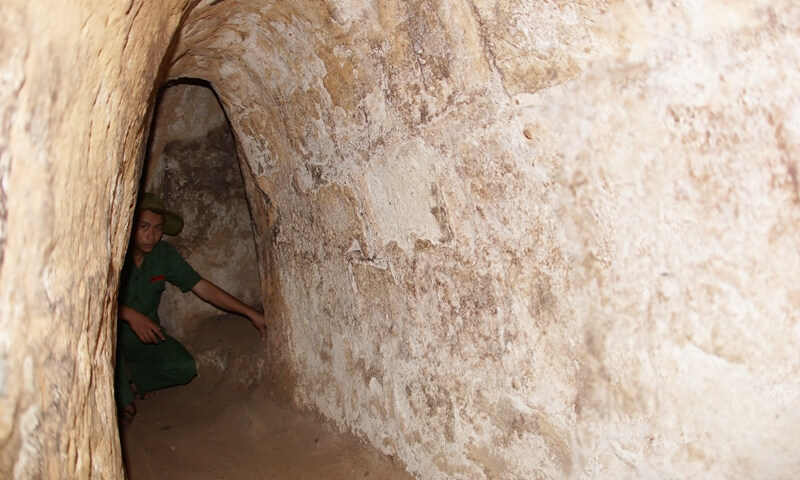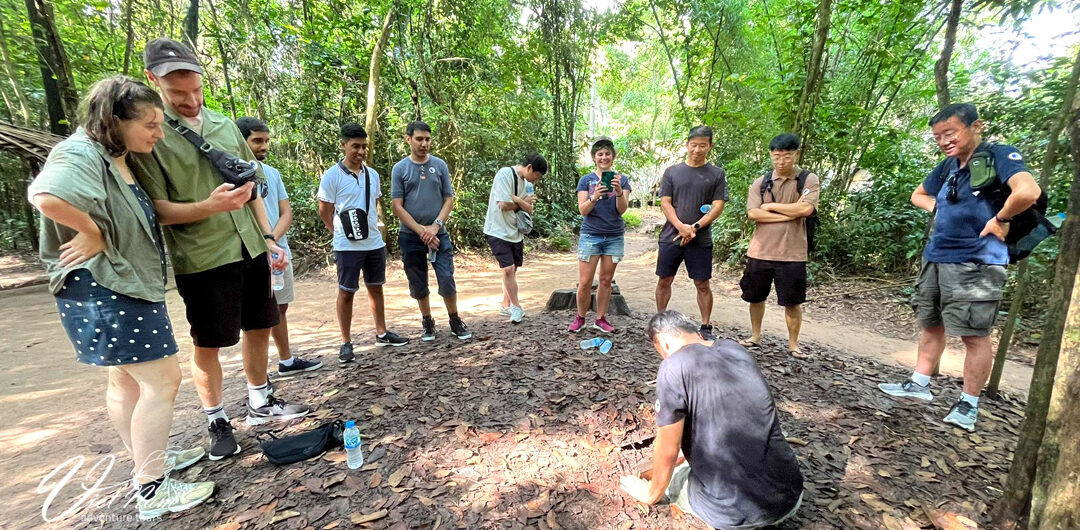Table of Contents
Nestled amidst the verdant landscapes of Vietnam Cu Chi Tunnels, a district located just northwest of Ho Chi Minh City, lies a sprawling network of underground tunnels that played a pivotal role in the Vietnam War. Known as the Cu Chi Tunnels, these interconnected passages served as a clandestine base for the Viet Cong guerrillas, enabling them to launch surprise attacks, evade enemy forces, and endure the harsh conditions of war. Delving into the history, significance, and intricacies of the Cu Chi Tunnels offers a profound insight into the indomitable spirit of the Vietnamese people and the resourcefulness they displayed in the face of adversity.
History of the Vietnam Cu Chi Tunnels

The origins of the Vietnam Cu Chi Tunnels can be traced back to the early 1940s, during the French colonial period. Initially constructed as a means of sheltering Vietnamese villagers from French air raids, these tunnels were later expanded and refined by the Viet Cong during the Vietnam War, transforming them into an elaborate subterranean fortress. The tunnels provided the Viet Cong with a strategic advantage, allowing them to move personnel and supplies undetected, set up隠れ家, and stage surprise attacks against American and South Vietnamese forces.
Significance of the Cu Chi Tunnels in Vietnam War
The Vietnam Cu Chi Tunnels played a crucial role in the Vietnam War, serving as a key base for the Viet Cong’s operations. These tunnels were strategically located near the Ho Chi Minh Trail, a major supply route for the North Vietnamese Army. By controlling this route, the Viet Cong were able to disrupt and delay the flow of supplies to the South Vietnamese and American forces, weakening their military efforts. The tunnels also served as a safe haven for the Viet Cong, providing them with shelter, food, and medical facilities.
The Cu Chi Tunnels also played a significant role in the Tet Offensive of 1968, one of the largest military campaigns launched by the North Vietnamese and Viet Cong forces against the South Vietnamese and American troops. The tunnels served as a base for the Viet Cong to launch surprise attacks on key targets, including the US Embassy in Saigon. This offensive marked a turning point in the war, as it showed the resilience and determination of the Viet Cong and their ability to strike at the heart of the enemy’s territory.
Construction and Design of the Vietnam Cu Chi Tunnels

The Cu Chi Tunnels are a testament to the ingenuity and perseverance of the Vietnamese people. These tunnels were built using simple tools such as shovels, hoes, and bamboo baskets, with most of the work done manually. The construction process was slow and laborious, with each tunnel taking several months to complete. The tunnels were dug in a zigzag pattern to prevent enemy soldiers from entering and to provide ventilation. They were also reinforced with wooden beams and bamboo traps to protect against bomb blasts.
Challenges Faced by the Viet Cong in Building the Cu Chi Tunnels
Building the Cu Chi Tunnels was no easy feat, and the Viet Cong faced numerous challenges during the construction process. The first and most significant challenge was the constant threat of being discovered by the enemy. To avoid detection, the Viet Cong had to dig the tunnels at night and camouflage the entrances during the day. They also had to deal with the harsh conditions of working underground, including lack of oxygen, high humidity, and cramped spaces.
Another major challenge was the constant bombing and shelling by American forces. The Viet Cong had to constantly repair and reinforce the tunnels to withstand the impact of bombs and grenades. They also had to deal with flooding during the rainy season, which required them to build drainage systems and pump out water from the tunnels.
Life inside the Vietnam Cu Chi Tunnels

The Vietnam Cu Chi Tunnels were not just a means of survival for the Viet Cong; they were also a way of life. The tunnels were equipped with living quarters, kitchens, and storage areas, providing the Viet Cong with all the necessities to sustain themselves during the war. They also had hospitals and schools inside the tunnels, where they treated wounded soldiers and educated their children.
Survival Techniques of the Viet Cong in the Cu Chi Tunnels
Living in the Cu Chi Tunnels required the Viet Cong to develop unique survival techniques. One of the most important skills was the ability to navigate through the complex network of tunnels without getting lost. To achieve this, the Viet Cong used a system of symbols and codes to mark different routes and locations within the tunnels.
They also had to adapt to the limited resources available underground. Food was scarce, and the Viet Cong had to rely on a diet of rice, cassava, and vegetables grown in small gardens within the tunnels. They also had to be creative in finding ways to cook and preserve food without attracting the attention of the enemy.
Military Strategies Used in the Cu Chi Tunnels

The Vietnam Cu Chi Tunnels were not just a hiding place for the Viet Cong; they were also a strategic military base. The tunnels were designed to provide the Viet Cong with a tactical advantage over their enemies. They had multiple entrances and exits, allowing for quick and easy movement of troops. The tunnels were also connected to booby traps and hidden pits, making it difficult for enemy soldiers to enter without being detected.
The Viet Cong also used the tunnels to launch surprise attacks on their enemies. They would emerge from hidden trapdoors and launch ambushes on unsuspecting American and South Vietnamese soldiers. This tactic not only caused confusion and chaos among the enemy forces but also demoralized them, as they never knew when or where the Viet Cong would strike.
Impact of the Cu Chi Tunnels on the Vietnamese People

The Vietnam Cu Chi Tunnels not only played a significant role in the Vietnam War but also had a profound impact on the Vietnamese people. The tunnels became a symbol of the resilience and determination of the Vietnamese people to defend their country against foreign invaders. They also served as a source of inspiration for future generations, reminding them of the sacrifices made by their ancestors in the fight for independence.
The tunnels also helped to unite the Vietnamese people, as they provided a safe haven for civilians during the war. Many villagers sought refuge in the tunnels to escape the bombings and attacks by American forces. This sense of community and solidarity among the Vietnamese people was crucial in their fight against the common enemy.
Tourism at the Cu Chi Tunnels

Today, the Cu Chi Tunnels have become a popular tourist destination, attracting thousands of visitors each year. The tunnels have been preserved and turned into a historical site, offering visitors a glimpse into the life of the Viet Cong during the war. Tourists can explore a section of the tunnels, visit the underground hospitals and kitchens, and see the various booby traps and weapons used by the Viet Cong.
Legacy of the Cu Chi Tunnels in Vietnam
The Cu Chi Tunnels hold a special place in the hearts of the Vietnamese people, serving as a reminder of their strength and resilience in the face of adversity. The tunnels have become a symbol of national pride and are often used as a backdrop for cultural events and celebrations. The legacy of the Cu Chi Tunnels continues to inspire the Vietnamese people to overcome challenges and persevere in the face of hardship.
Conclusion

The Vietnam Cu Chi Tunnels are not just a network of underground passages; they are a testament to the unwavering spirit and ingenuity of the Vietnamese people. These tunnels played a crucial role in the Vietnam War, providing the Viet Cong with a strategic advantage and serving as a symbol of resistance against foreign invaders. Today, the Cu Chi Tunnels stand as a powerful reminder of the resilience and resourcefulness of the Vietnamese people, and their enduring legacy continues to inspire generations to come.